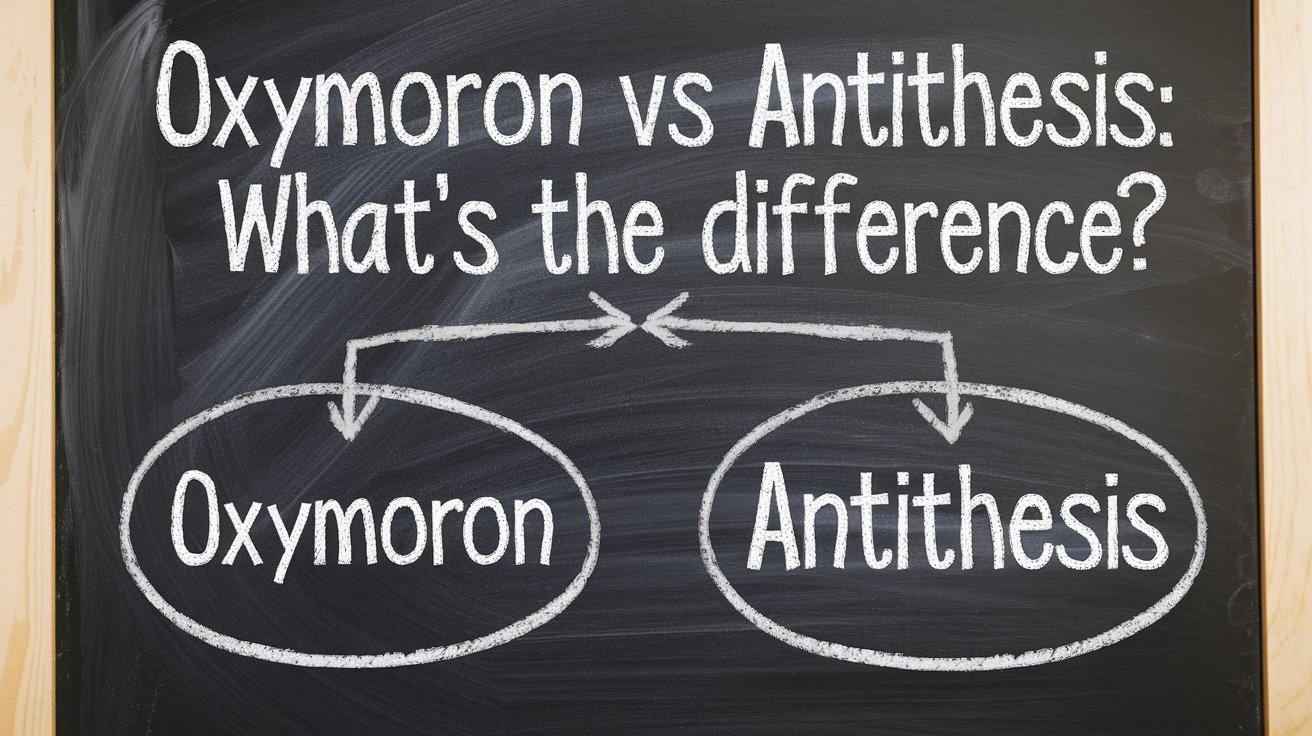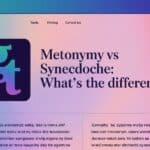Oxymoron vs Antithesis: What’s the difference? Understanding these two literary devices can be tricky, but it’s crucial for anyone studying language and literature. Both oxymorons and antitheses involve contrasts, yet they serve different purposes.
While an oxymoron combines two opposing words to create a unique expression, an antithesis presents two contrasting ideas in parallel structure.
By exploring their differences, you can unlock a deeper understanding of how language creates impact. In this article, we’ll delve into the characteristics and uses of both, clarifying their roles in writing and speech.
📝 Table of Contents
🔍 Understanding Oxymoron
- What is Oxymoron?
- Examples of Oxymoron
- Origins of Oxymoron
⚖️ Exploring Antithesis
- What is Antithesis?
- Examples of Antithesis
- Origins of Antithesis
🔄 Comparing Oxymoron vs Antithesis
- Oxymoron vs Antithesis: The Differences
- How To Use Oxymoron and Antithesis in Sentences
- Using Oxymoron
- Using Antithesis
- Combining Oxymoron and Antithesis
💡 Practical Applications
- Examples of Oxymoron and Antithesis Used in Sentences
- Common Mistakes to Avoid when using Oxymoron and Antithesis
- Tips for Avoiding These Mistakes
📍 Usage Guidelines
- Where to Use Oxymoron and Antithesis
- Where Not to Use Oxymoron and Antithesis
What Is Antithesis? – Meaning and Definition
Antithesis is a rhetorical device that contrasts two opposing ideas in a balanced or parallel structure. It highlights the stark differences between concepts to create emphasis and impact.
Often used in literature, speeches, and everyday conversation, it helps to bring clarity to contrasting viewpoints.
For example, “It was the best of times, it was the worst of times” from A Tale of Two Cities uses antithesis to draw attention to contrasting states of society. This technique strengthens the argument and makes the message memorable.
‘Oxymoron vs Antithesis: What’s The Difference?

The difference between oxymoron and antithesis lies in how they present contrasting ideas. Let’s break it down:
Oxymoron
An oxymoron is a figure of speech where two contradictory or opposite words are placed together in a way that creates a new, often paradoxical meaning. These words usually work together to evoke irony or a deeper understanding of something complex.
Example:
- “Bittersweet” – Combines sweetness and bitterness, conveying mixed emotions or experiences.
- “Deafening silence” – The concept of silence, typically associated with peace, being so overwhelming that it’s almost loud.
Key Point: An oxymoron juxtaposes two contradictory words within a single phrase.
Antithesis
Antithesis is a rhetorical device that presents two opposite ideas or concepts in a parallel structure to highlight their stark contrast. It’s typically used to emphasize differences and create a stronger impact.
Example:
- “It was the best of times, it was the worst of times” (Charles Dickens) – A clear contrast between extremes, creating a sense of conflict.
- “Give me liberty, or give me death!” – A direct contrast between the concepts of liberty and death.
Key Point: An antithesis contrasts larger ideas or concepts and usually involves a balanced structure.
Key Differences
Nature of Contrast:
- Oxymoron: Combines two contradictory words in one phrase.
- Antithesis: Contrasts two opposing ideas or concepts.
Structure:
- Oxymoron: A short phrase with contradictory words (e.g., “jumbo shrimp”).
- Antithesis: A longer comparison where the opposites are presented in parallel sentences or clauses (e.g., “love and hate”).
Purpose:
- Oxymoron: Often used to express complexity or irony in a single idea.
- Antithesis: Used to emphasize the contrast between two opposing concepts or ideas.
What Differentiates an Antithesis from an Oxymoron?
The main difference between an antithesis and an oxymoron lies in how contrast is presented. An antithesis involves two distinct, often opposing ideas that are placed in close proximity, usually in parallel structure.
In contrast, an oxymoron combines two contradictory words together to form a single, complex idea, like “jumbo shrimp.”
While both techniques rely on contrast, antithesis emphasizes the relationship between the ideas, while oxymoron focuses on the paradox of the individual words.
Oxymoron vs Antithesis: The Differences In Meanings
The oxymoron and antithesis are both literary devices that deal with contrasts, but they are used in different ways and have distinct meanings. Let’s break down their meanings and highlight the key differences.
1. Oxymoron: Meaning
An oxymoron is a figure of speech where two contradictory or opposite words are placed together in a way that makes sense and creates a unique or paradoxical effect.
These combinations often provoke thought by showing how seemingly incompatible ideas can coexist or create a deeper meaning.
Examples of Oxymorons:
- “Deafening silence” – The contradiction of silence being deafening creates a vivid image of an overwhelming quietness.
- “Bittersweet” – Combines both the sweetness and bitterness of an emotion or experience, often used to describe something that is both happy and sad at the same time.
- “Jumbo shrimp” – A combination of something being large (jumbo) and small (shrimp), highlighting the irony.
Meaning in essence: An oxymoron juxtaposes two contradictory terms that seem incompatible but create a new meaning when paired together.
2. Antithesis: Meaning
An antithesis is a rhetorical device that presents two contrasting ideas or opposites in a balanced structure to highlight their differences. It often appears in parallel forms, where one idea directly opposes another. The goal of an antithesis is to emphasize the sharp contrast between two ideas or concepts.
Examples of Antithesis:
- “It was the best of times, it was the worst of times” – This famous opening from Charles Dickens’ A Tale of Two Cities contrasts two opposing concepts to highlight the extremes of the period.
- “Give me liberty, or give me death!” – A stark contrast between the desire for freedom and the consequences of not achieving it.
- “To be, or not to be” – A famous line from Shakespeare’s Hamlet expressing a direct contrast between existence and non-existence.
Meaning in essence: An antithesis contrasts two opposing ideas within a balanced structure to emphasize their differences or highlight the conflict.
3. Key Differences in Meaning
Structure of Contrast:
- An oxymoron places two opposite words together in a short phrase, creating a paradox that highlights an ironic or complex concept.
- An antithesis involves two contrasting ideas presented in parallel or balanced phrases, emphasizing the sharp differences between them.
Effect:
- The oxymoron creates a single paradoxical effect, usually by merging opposites that challenge conventional thinking.
- The antithesis highlights conflict or opposition between ideas, often creating tension or emphasizing a moral, philosophical, or ideological struggle.
Oxymoron vs Antithesis: The Differences In different Culture
The oxymoron and antithesis are both literary devices that highlight contrasts, but they differ in how they present these oppositions and how they are used in different cultures. Let’s explore the key differences between them and how they are perceived or used across various cultural contexts.
1. Oxymoron
An oxymoron is a figure of speech in which two seemingly contradictory or opposing words are placed side by side to create a new, often thought-provoking, meaning.
The contradiction in oxymorons is usually more subtle and can evoke a sense of irony or complexity. Common examples in English include “bittersweet”, “deafening silence”, or “virtual reality.”
In different cultures, oxymorons can vary based on the language and worldview:
- In Western cultures, oxymorons often reflect a paradox of modern life, where complexity and contradiction are embraced. For instance, terms like “organized chaos” or “controlled freedom” reflect this complexity.
- In Eastern cultures, particularly in places like China or Japan, oxymorons can often be used to reflect the balance or duality found in traditional philosophies like Taoism. An example might be the “soft strength” or the concept of “yin-yang”, which inherently contains opposing forces that work together harmoniously.
2. Antithesis
Antithesis, on the other hand, is a rhetorical device that presents two opposite ideas or contrasting concepts in a balanced or parallel structure. It emphasizes the stark contrast between these ideas and often highlights a more direct opposition.
Classic examples include “It was the best of times, it was the worst of times” (Charles Dickens) or “Give me liberty, or give me death!” (Patrick Henry).
In terms of cultural significance:
- In Western literature, antithesis is often used to present moral, philosophical, or emotional conflicts. The contrast could be between good and evil, freedom and oppression, or light and darkness. It’s used to express clear distinctions in values, ideals, and beliefs.
- In Middle Eastern or South Asian cultures, antithesis might be used in poetry and philosophy to reflect duality or struggle. For example, in Persian poetry, you might see contrasts between life and death or joy and sorrow, which reflect the transient nature of existence and the cycle of life.
Must read: Totalling or Totaling: Which Spelling to Use?
What Differentiates an Antithesis from an Oxymoron?
The main difference between an antithesis and an oxymoron lies in how contrast is presented. An antithesis involves two distinct, often opposing ideas that are placed in close proximity, usually in parallel structure.
In contrast, an oxymoron combines two contradictory words together to form a single, complex idea, like “jumbo shrimp.”
While both techniques rely on contrast, antithesis emphasizes the relationship between the ideas, while oxymoron focuses on the paradox of the individual words.
Some Common Examples of Antithesis
Antithesis is widely used in literature and everyday speech. Famous examples include “to be or not to be” from Hamlet, which contrasts existence with non-existence.
Another example is “Love is an ideal thing, marriage a real thing.” These examples use clear, direct contrasts to highlight conflicting themes or viewpoints.
In speeches, you might hear phrases like “We must learn to live together as brothers or perish together as fools,” which highlights the urgency of unity versus division. Antithesis brings drama and clarity to these messages.
What is Oxymoron?
An oxymoron is a figure of speech where two contradictory terms are combined to create a unique and thought-provoking expression. These seemingly paradoxical pairs often create a deeper meaning or evoke curiosity.
For example, the term “bittersweet” combines opposing emotions of joy and sorrow to reflect complex feelings. The juxtaposition of contrasting words like this makes the oxymoron an effective literary device, adding nuance to language and prompting deeper reflection.
Examples of Oxymoron
Some common examples of oxymorons include “deafening silence,” “jumbo shrimp,” and “living dead.” These phrases combine contradictory ideas to evoke a sense of irony or highlight complex situations.
In literature and everyday speech, oxymorons help convey emotions or conditions that aren’t easily described with straightforward words. The pairing of opposites challenges the listener or reader to think more deeply about the concept or idea being presented.
Origins of Oxymoron
The term “oxymoron” comes from Greek, where “oxys” means sharp or keen, and “moros” means dull or foolish. The combination of these two words itself is an oxymoron, symbolizing the paradox at its core.
This figure of speech has been used in various forms since ancient times, notably in Greek tragedies and plays. Through the ages, oxymorons have been employed to illustrate contradictions or enhance the emotional impact of a message, becoming a popular tool in literature, poetry, and everyday language.
What is Antithesis?
Antithesis is a rhetorical device that contrasts two opposing ideas to create a balanced, thought-provoking effect. By juxtaposing opposing concepts, it highlights the differences and deepens the understanding of each idea.
A classic example of antithesis is “It was the best of times, it was the worst of times,” which contrasts optimism with despair. This stark contrast not only emphasizes the extremes but also adds depth to the statement.
Examples of Antithesis
Famous examples of antithesis include “Give me liberty or give me death” and “Speech is silver, but silence is golden.” These phrases contrast two extremes, often in parallel structure, to create a striking effect.
In speeches, literature, and daily conversations, antithesis helps to clarify ideas by emphasizing their opposing qualities. This technique makes it easier for the audience to comprehend the complexities of the ideas being discussed.
Origins of Antithesis
The word “antithesis” comes from the Greek word “antitithenai,” meaning “to oppose.” It has been used in rhetoric and literature for centuries to present contrasting ideas in a powerful way.
Ancient Greek philosophers like Aristotle often discussed antithesis as a tool for argumentation, and it was used extensively in classical tragedies and speeches.
Over time, the technique spread across various cultures and remains a vital rhetorical device today.
Oxymoron vs Antithesis: The Differences
While both oxymorons and antitheses involve contrast, the key difference lies in how they express it. An oxymoron places two contradictory terms together to form a paradoxical concept, such as “virtual reality.”
On the other hand, an antithesis presents two opposing ideas or themes in parallel structure to emphasize their differences, like “love and hate.” While both devices create tension and provoke thought, oxymoron focuses on words, and antithesis focuses on ideas.
Understanding Contrast in Language
Both oxymorons and antitheses are devices that utilize contrast, but they do so in distinct ways. These rhetorical tools help to highlight opposites and create tension in writing, forcing readers to reflect on the meaning behind the contrasts.
While they share the idea of opposition, the way they are structured and used differs. Understanding the nuances between the two can improve your ability to use them effectively in your writing. Let’s break down the differences between oxymoron and antithesis and explore how each works.
Oxymoron: Pairing Contradictory Terms
An oxymoron is a figure of speech where two contradictory or opposite words are placed together to create a paradox. This pairing of opposites produces an intriguing effect, encouraging readers to think more deeply about the relationship between the words.
Common examples include “jumbo shrimp” or “deafening silence.” In both cases, the two words contradict each other, but together they create a new, often complex meaning. The power of an oxymoron lies in its ability to combine words that don’t logically go together, offering a layered interpretation.
Antithesis: Highlighting Opposing Ideas
In contrast, an antithesis focuses on contrasting whole ideas or concepts rather than individual words. It presents two opposing ideas in parallel structure to emphasize their differences.
The purpose of an antithesis is to highlight the contrast between these ideas and draw attention to the conflict or tension between them. A famous example is “It was the best of times, it was the worst of times,” from A Tale of Two Cities by Charles Dickens.
Here, the two opposing concepts of “best” and “worst” are presented side by side to emphasize the stark differences between them.
Key Difference: Words vs. Ideas
The key difference between oxymoron and antithesis is the level at which the contrast occurs. An oxymoron works at the word level, combining two contradictory terms into a single phrase or expression.
The focus is on individual words that, when placed together, create a paradoxical idea. On the other hand, an antithesis operates at the level of ideas or themes, juxtaposing entire concepts to emphasize their opposition.
While both devices create contrast, an oxymoron does so by highlighting contradictions between words, and an antithesis does so by presenting opposing ideas in parallel.
How To Use Oxymoron and Antithesis In Sentences
Using oxymoron and antithesis can enhance your writing by making it more expressive and engaging. When crafting a sentence with an oxymoron, think of pairing two contradictory terms that offer a deeper meaning. For example, “Her silent scream echoed in my mind.”
For antithesis, focus on contrasting two ideas or concepts, such as “It’s not the years in your life, but the life in your years.” Both devices add flair and depth to your writing.
Using Oxymoron
When using an oxymoron, choose words that are seemingly contradictory but create a meaningful image. You might say, “Her icy fire burned brightly,” combining cold and heat to describe someone’s passion in a unique way.
This technique draws attention to the paradox, making your writing more memorable. The oxymoron can also convey emotions, states of being, or situations that are difficult to describe otherwise.
Using Antithesis
Incorporating antithesis into your writing involves setting two opposing ideas side by side to highlight their differences. For instance, “To err is human; to forgive, divine.”
This example contrasts human flaws with the divine quality of forgiveness, creating a powerful message. Antithesis works best when you want to emphasize a dichotomy, such as good versus evil, light versus dark, or life versus death.
Combining Oxymoron and Antithesis
Combining oxymoron and antithesis can create a striking contrast that adds complexity and depth to your writing. For instance, in the phrase “a bitter sweetness of love,” the oxymoron adds a paradox, while the broader contrast between love and bitterness forms an antithesis.
This combination emphasizes the internal conflict within a concept or theme, providing more layers of meaning.
Examples Of Oxymoron and Antithesis Used In Sentences
Here are some examples of oxymoron and antithesis in sentences:
- Oxymoron: “Her quiet roar broke the silence.”
- Antithesis: “It was the best of times, it was the worst of times.”
- Both examples show how contrast works to convey powerful emotions or ideas. In one, opposing qualities of sound (quiet and roar) highlight a surprising situation, while in the other, two extremes (best and worst) emphasize the complexity of a moment in time.
Oxymoron
An oxymoron can infuse your writing with intrigue by combining contradictory terms. For instance, “open secret” presents an impossible scenario, yet one that might make perfect sense in a specific context.
These devices often highlight contradictions in life or emotions, making readers pause and reconsider their assumptions about reality.
Antithesis
Antithesis works by placing opposing ideas side by side to deepen understanding. Think of “love conquers all, but hate destroys everything
This comparison highlights the force of love and the destructiveness of hate. By setting these ideas in opposition, antithesis forces the reader to reflect on the power of both.
Combined Use of Oxymoron and Antithesis
Combining oxymoron and antithesis enriches your writing by offering a multi-layered perspective. Imagine writing “The darkness of her love was both warm and cold,” where the oxymoron (“warm and cold”) merges with an antithesis that contrasts love’s warmth with its darkness.
This combination deepens the emotional impact, engaging the reader on a more intellectual level.
You will like: Excell or Excel: What is the Correct Spelling?
Common Mistakes to Avoid when using Oxymoron and Antithesis
One common mistake when using oxymoron and antithesis is overdoing the contrast to the point of confusion. For example, forcing two opposing terms together without a clear purpose can weaken the impact of your writing.
Another mistake is failing to ensure that the contrast enhances the message or theme, making it feel forced or out of place. These devices should feel natural and meaningful.
The Importance of Proper Use of Oxymoron and Antithesis
Oxymoron and antithesis are both powerful rhetorical devices used to create contrast in writing. However, when these devices are used incorrectly, they can diminish the clarity and strength of the writing.
The key to using them effectively is ensuring that they enhance the overall message or theme of the piece without confusing the reader.
In this article, we will explore some common mistakes to avoid when using oxymoron and antithesis, helping you to master these techniques in a way that makes your writing more impactful.
Overuse of Contrast Leading to Confusion
One of the most frequent errors when using oxymoron and antithesis is overdoing the contrast. While both devices rely on presenting opposing ideas, forcing too many contradictory elements into a single sentence or paragraph can create confusion.
For example, if you use too many conflicting phrases or ideas without a clear connection, the writing will lose its impact and fail to convey a coherent message.
Instead, it’s essential to use contrast sparingly and intentionally, making sure it adds to the understanding of the theme rather than detracting from it.
Using Contrasts Without a Clear Purpose
Another mistake is using oxymoron or antithesis without a clear purpose behind the contrast. Both devices should serve a role in your writing, whether to highlight irony, emphasize a theme, or enhance character development.
When used thoughtlessly, these contrasts can feel forced or awkward. The key is to ensure that the contrast enhances the message, whether by revealing a deeper meaning or drawing attention to a specific concept. A forced or out-of-place contrast can leave the reader puzzled rather than impressed.
Inconsistent or Unbalanced Pairings
For oxymorons and antitheses to be effective, the two opposing elements must be well-chosen and balanced. A common mistake is to pair contrasting terms or ideas that don’t make sense together or don’t have a clear relationship.
For example, an oxymoron like “jumbo shrimp” is effective because the words create a meaningful, albeit surprising, contrast.
On the other hand, pairing words that don’t have a logical connection can weaken the impact of the contrast and make the writing feel incoherent. Consistency and balance are essential to maintaining the effectiveness of these devices.
Failing to Maintain the Flow of the Narrative
While oxymorons and antitheses can add depth to your writing, they must be integrated seamlessly into the flow of the narrative. If these devices are used too frequently or placed awkwardly in the text, they can interrupt the natural rhythm of the writing and make it harder for the reader to follow the story or argument.
It’s important to ensure that the contrasts do not disrupt the pacing of the piece but instead flow naturally, contributing to the overall tone and message without causing unnecessary distractions.
Tips for Avoiding These Mistakes
To avoid overusing oxymoron and antithesis, make sure the contrast serves a purpose in your writing. It should clarify, emphasize, or enhance the point you’re trying to make, not distract from it.
If you’re unsure, read your sentence aloud. Does the contrast enhance the message? If not, you might need to adjust it or remove unnecessary opposites that don’t contribute meaningfully.
Clarify the Purpose of Contrast
When using oxymorons and antitheses, always ensure that the contrast you’re creating serves a clear purpose. The primary goal is to clarify or emphasize an idea, making it easier for the reader to understand the deeper message you’re trying to convey.
Ask yourself: Does the contrast provide insight into the theme, character, or situation? If the answer is yes, then it’s likely to be effective. If the contrast feels unnecessary or irrelevant, it might be best to remove it.
Read Aloud for Natural Flow
A helpful tip for assessing the effectiveness of oxymoron and antithesis in your writing is to read your sentences aloud. Doing so will help you identify whether the contrast flows naturally or feels forced. When reading, listen for any awkward pauses or jarring shifts in tone that might distract from your message.
If the contrast feels disruptive rather than enhancing the idea, consider revising or simplifying the phrasing to make it feel more integrated into the overall narrative.
Limit the Use of Contrasts in One Section
Overuse of oxymoron and antithesis can clutter your writing, reducing the impact of these devices. Limit the number of contrasts within a single paragraph or section of your work. Instead, space out these devices across your writing so that each one feels significant when it appears.
If you find yourself using multiple contrasts in a short span of text, evaluate whether each one is essential. Often, fewer, more impactful contrasts will make a greater impression than overloading your writing with opposing terms.
Balance the Contrast for Effectiveness
Ensure that the opposing elements in your oxymoron or antithesis are balanced and make sense within the context. A common mistake is to pair two ideas or phrases that don’t have an obvious or meaningful relationship.
For example, “silent noise” or “unbreakable glass” may create confusion if the contrast feels too extreme or doesn’t contribute to the theme. Take time to think about how the two elements complement each other and how they can highlight a key aspect of your writing, whether it’s a theme, character trait, or message.
Revise and Refine for Clarity
Finally, always take the time to revise and refine your writing. After incorporating oxymorons or antitheses, review your sentences to ensure the contrast doesn’t undermine your clarity. Sometimes, a contrast may initially sound clever but, upon further inspection, might seem confusing or out of place.
Simplifying the contrast or adjusting your wording to make it clearer can make a big difference. Aim for precision and clarity, ensuring that every contrast you use strengthens your overall message without causing unnecessary confusion.
Where to Use Oxymoron and Antithesis
Oxymorons and antitheses are most effective in persuasive writing, poetry, literature, and speeches. They work well when you want to add complexity, create emphasis, or evoke strong emotions.
Whether you’re exploring contradictions in human nature or discussing profound ideas, these devices can help bring your message to life in a powerful way. Use them sparingly, though, to maintain their impact.
Understanding Effective Placement of Contrasting Devices
Oxymorons and antitheses are powerful literary devices that create contrast, provoke thought, and add depth to your writing. These devices are particularly effective in areas where emotional appeal, complexity, and thematic exploration are key.
However, to make the most of oxymorons and antitheses, they should be used in the right context and with intentionality. In this section, we will explore where these devices shine and how they can enhance different forms of writing.
Persuasive Writing: Enhancing Argumentation and Emotional Appeal
In persuasive writing, oxymorons and antitheses can be used to highlight opposing viewpoints, create tension, or underscore the importance of an argument.
These devices can help sharpen the contrast between two ideas, making the stakes of your argument clearer to your audience. For example, using an antithesis such as “freedom and oppression” can emphasize the gravity of a political argument.
Similarly, an oxymoron like “deafening silence” can evoke a deep emotional response, strengthening the persuasive power of your writing. In persuasive contexts, these devices can make your points more compelling and memorable, but they should be used sparingly to avoid overwhelming your audience.
Poetry: Adding Depth and Complexity to Themes
Poetry thrives on brevity, symbolism, and emotional resonance, and both oxymorons and antitheses can elevate these aspects. An oxymoron like “bittersweet love” or “dark light” can perfectly capture the contradictory emotions that often characterize human experiences.
Similarly, an antithesis can emphasize the tension between opposing ideas, as in “life and death” or “love and hate,” bringing layers of meaning to the poem. The contrast between opposing ideas or words can add complexity to the themes, enriching the overall emotional and intellectual experience of the reader.
In poetry, these devices should be employed thoughtfully to avoid over-complicating the meaning, ensuring that each contrast serves the poem’s central theme.
Literature: Character Development and Thematic Exploration
In literature, both oxymorons and antitheses are commonly used to develop complex characters or explore profound themes. For example, a character who embodies contradictions—such as a “friendly enemy” or a “loyal traitor”—can be portrayed using oxymorons, which deepen the complexity of their personality.
An antithesis can be used to set up a conflict between two opposing forces, such as good versus evil or civilization versus chaos, which is a common theme in many literary works.
These devices help convey the struggle between different ideas or qualities, often providing insight into the human condition. Whether in dialogue, description, or narration, using these devices strategically can help create more nuanced and engaging stories.
Speeches: Persuasion and Impactful Delivery
In speeches, oxymorons and antitheses are frequently used to create a dramatic impact, engage the audience, and emphasize key messages. Political leaders, orators, and motivational speakers often use these devices to highlight contrasts and provoke thought.
For instance, Martin Luther King Jr.’s famous “I have a dream” speech includes the use of antithesis when he speaks of a “nation where they will not be judged by the color of their skin but by the content of their character.”
The contrast between judgment based on skin color and judgment based on character emphasizes the moral high ground of his argument. In speeches, these devices can be powerful tools for reinforcing a message, creating a rhythm that resonates with the audience, and leaving a lasting impact.
Where Not to Use Oxymoron and Antithesis
Avoid using oxymorons and antitheses in places where clarity is essential. Overusing these devices in technical or academic writing may confuse the reader.
These techniques work best in creative writing or persuasive contexts, where evoking emotion and adding layers of meaning are the goals. Too much contrast can make your message harder to follow. Keep it balanced and relevant to the point you’re trying to make.
Understanding When Not to Use Contrasting Devices
While oxymorons and antitheses can be powerful rhetorical tools, it’s important to recognize where not to use them. These devices are excellent for creating contrast, highlighting complexity, or evoking emotion.
However, their overuse or misplacement in certain contexts can detract from the clarity of your writing. Knowing when to avoid these devices will help you maintain the focus and effectiveness of your message, ensuring your writing remains accessible and coherent to your audience.
Avoiding Overuse in Technical Writing
In technical writing, clarity and precision are paramount. The primary goal is to communicate information in a straightforward, understandable manner.
Using oxymorons or antitheses in technical documents—such as user manuals, scientific papers, or instructional guides—can introduce unnecessary confusion.
For example, phrases like “controlled chaos” or “brief eternity” might leave readers puzzled or distracted, making it harder for them to follow complex instructions or absorb technical details.
In such contexts, it’s best to stick to clear, unambiguous language that ensures accuracy and comprehension.
Refraining from Using Contrasts in Academic Writing
Similar to technical writing, academic writing demands a high degree of clarity and focus. While some rhetorical devices, including oxymorons and antitheses, can be effective in argumentation or analysis, they should be used sparingly.
Overusing contrast in academic contexts, such as research papers or essays, can weaken the logical flow of your argument and make it harder for readers to follow your reasoning.
Instead, academic writing should prioritize clear definitions, well-supported claims, and logical progression of ideas, reserving rhetorical devices for moments that truly enhance the discourse.
Creative Writing and Persuasive Contexts: Where These Devices Shine
Oxymorons and antitheses excel in creative writing and persuasive contexts. In poetry, fiction, or persuasive essays, these devices can evoke strong emotions, challenge conventional thinking, and add depth to the narrative. For instance, in a poem, an oxymoron like “bittersweet joy” can vividly express complex emotional states.
In persuasive writing, antitheses can highlight opposing viewpoints to make the argument more compelling, as seen in the phrase “freedom and tyranny.” Here, the contrast serves to sharpen the focus and emphasize the central message.
Maintaining Balance and Relevance
The key to using oxymorons and antitheses effectively is balance. While these devices can enrich creative and persuasive writing, too much contrast can make your message convoluted.
Excessive use of opposites can confuse readers, dilute the impact of your message, and hinder your ability to convey your point clearly. To avoid this, ensure that the contrasts are relevant to the theme or point you’re making.
When in doubt, limit the number of oxymorons or antitheses in a single passage and ensure they contribute meaningfully to the tone, message, or character development.
You will like: Cart vs Kart: Which Spelling to Use?
FAQ’S
What is the main difference between oxymoron and antithesis?
An oxymoron combines two contradictory terms (e.g., “jumbo shrimp”), while an antithesis contrasts two opposing ideas or concepts (e.g., “It was the best of times, it was the worst of times”).
Can an oxymoron be used in everyday conversation?
Yes, oxymorons are commonly used in everyday language to express complex or ironic situations, such as saying “living dead” or “deafening silence.”
Are oxymorons and antitheses the same thing?
No, although both involve contrast, oxymorons focus on contradictory words, while antitheses highlight opposing ideas or themes within a sentence or structure.
Where can I use oxymorons and antitheses in writing?
Oxymorons and antitheses are best used in creative writing, speeches, and literature to emphasize contradictions, enhance emotional impact, or clarify complex ideas.
Can I combine oxymorons and antitheses in one sentence?
Yes, combining oxymorons and antitheses can create a richer and more layered sentence, adding depth by juxtaposing contradictory terms and ideas.
Are oxymorons and antitheses always effective in writing?
Not always. While both can be powerful, overusing them can confuse the reader or weaken the message. Use them strategically to enhance the overall tone or theme.
Can antithesis be used in poetry?
Yes, antithesis is commonly used in poetry to draw attention to contrasts and add dramatic effect, helping convey complex themes or emotions with impact.
Conclusion
In conclusion, understanding the difference between oxymoron and antithesis enriches our appreciation of language. Both literary devices serve to highlight contrasts, but in unique ways.
Oxymorons combine contradictory terms, creating paradoxes that invite deeper reflection. Meanwhile, antitheses place opposing ideas side by side to emphasize their differences.
When used effectively, both can add complexity, emotion, and clarity to writing. By mastering these tools, you can enhance your writing and communication, making it more engaging and thought-provoking.

Joulia, a seasoned wordsmith and grammar enthusiast, brings over a decade of blogging expertise to Grammar Tune. With a keen eye for linguistic precision and a passion for making complex grammar concepts accessible, he has helped thousands of readers enhance their writing skills. His engaging teaching style and practical approach to language learning have made him a trusted voice in the online grammar community.







